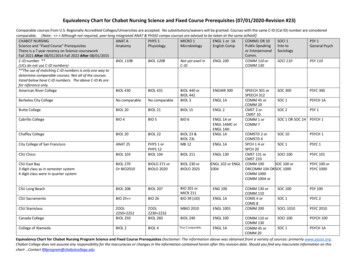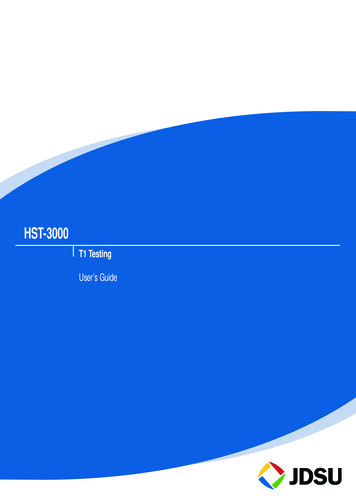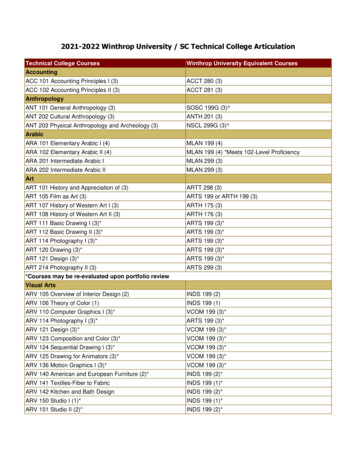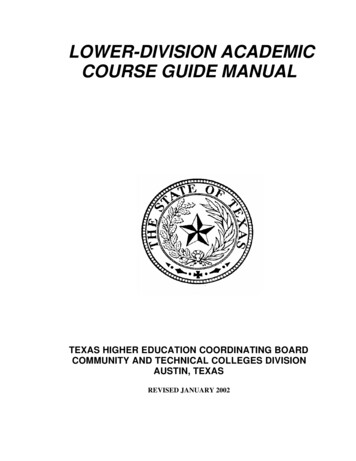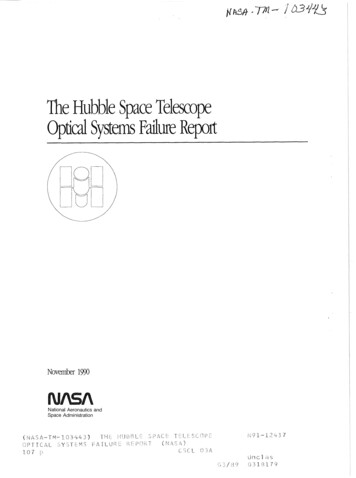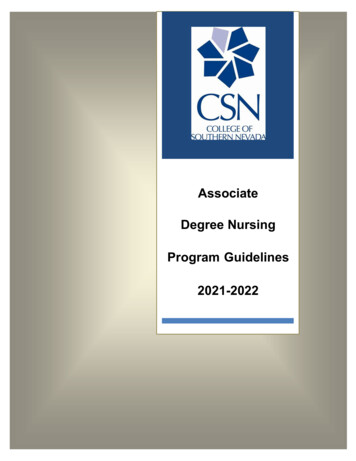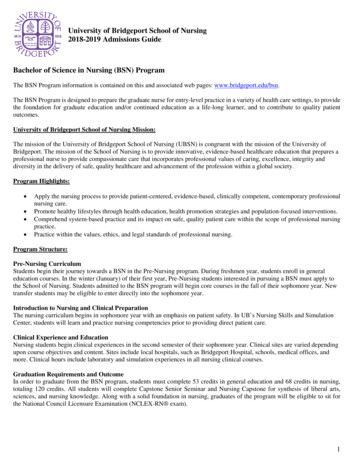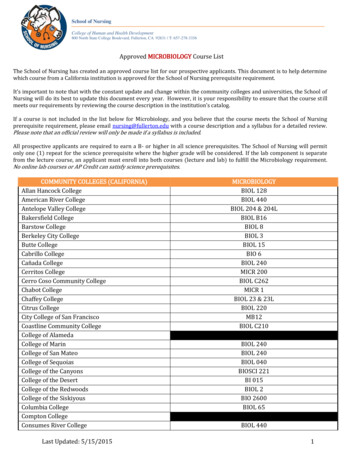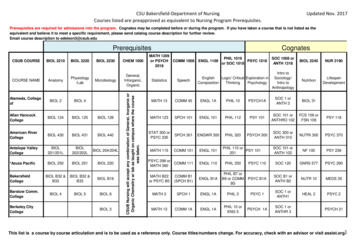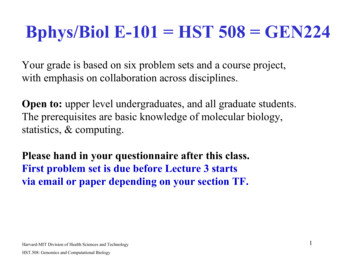
Transcription
Bphys/Biol E-101 HST 508 GEN224Your grade is based on six problem sets and a course project,with emphasis on collaboration across disciplines.Open to: upper level undergraduates, and all graduate students.The prerequisites are basic knowledge of molecular biology,statistics, & computing.Please hand in your questionnaire after this class.First problem set is due before Lecture 3 startsvia email or paper depending on your section TF.Harvard-MIT Division of Health Sciences and TechnologyHST.508: Genomics and Computational Biology1
Bio 101: Genomics &Computational BiologyWeek#1 Intro 1: Computing, Statistics, Perl, MathematicaWeek#2 Intro 2: Biology, comparative genomics, models & evidence, applicationsWeek#3 DNA 1: Polymorphisms, populations, statistics, pharmacogenomics, databasesWeek#4 DNA 2: Dynamic programming, Blast, multi-alignment, HiddenMarkovModelsWeek#5 RNA 1: 3D-structure, microarrays, library sequencing & quantitation conceptsWeek#6 RNA 2: Clustering by gene or condition, DNA/RNA motifs.Week#7 Protein 1: 3D structural genomics, homology, dynamics, function & drug designWeek#8 Protein 2: Mass spectrometry, modifications, quantitation of interactionsWeek#9 Network 1: Metabolic kinetic & flux balance optimization methodsWeek#10 Network 2: Molecular computing, self-assembly, genetic algorithms, neural-netsWeek#11 Network 3: Cellular, developmental, social, ecological & commercial modelsWeek#12 Project presentationsWeek#13 Project PresentationsWeek#14 Project Presentations2
Intro 1: Today's story, logic & goalsLife & computers : Self-assembly requiredDiscrete & continuous modelsMinimal life & programsCatalysis & ReplicationDifferential equationsDirected graphs & pedigreesMutation & the Single Molecules modelsBell curve statisticsSelection & optimality3
101101101101 1100 1 11 01 1100 1 11 01 101 101 10110111 00 11101 11 00 11101 11 00 11101111100001111 111100 11 0011 1100 11001111 1111100 11 011 11 0 000 111001111 111100 11 0011 1100 11001111 111100 0011 11101 101 101 11010 1011 110111 00 11101 11 00 11101 10 1 01 10 1011 110011111100001111 111011100 11 00 111 1100 1100011111 111100 11 0011 1100 11001111 111100 11 0011 1100 11001111 111100 00411 114
acgt10110110110110110155
gggatttagctcagttgggagagcgccagactgaagatPost- 300genomes &3D structuresttggaggtcctgtgttcgatccacagaattcgcacca66
Discretea sequencelatticedigitalΣ xneural/regulatory on/offsum of black & whiteessential/neutralalive/notContinuousa weight matrix of sequencesmolecular coordinatesanalog (16 bit A2D converters)dxgradients & graded responsesgrayconditional mutationprobability of replication7
Bits (discrete)bit binary digit1 base 2 bits1 byte 8 bits Kilo Mega Giga Tera Peta Exa Zetta Yotta 36912 15 182124- milli micro nano pico femto atto zepto yocto Kibi Mebi Gibi Tebi Pebi Exbi1024 210 220 230240 250 8
Defined quantitative measuresSeven basic (Système International) SI units:s, m, kg, mol, K, cd, A(some measures at precision of 14 significant figures)Quantal: Planck time, length: 10-43 seconds, 10-35 meters,mol 6.0225 1023 entities.casa.colorado.edu/ inty/scienceworld.wolfram.com/physics/SI.html9
Quantitative definition of life?Historical/Terrestrial Biology vs "General Biology"Probability of replication of complexity from simplicity(in a specific environment)Robustness/Evolvability(in a variety of environments)Examples: mules, fires, nucleating crystals,pollinated flowers, viruses, predators,molecular ligation, factories, self-assembling machines.10
Complexity definitions1. Computational Complexity speed/memory scaling P, NP2. Algorithmic Randomness (Chaitin-Kolmogorov)3. Entropy/information4. Physical complexity(Bernoulli-Turing Machine)Crutchfield & Young in Complexity, Entropy, & the Physics of Information 1990 pp.223-269www.santafe.edu/ jpc/JPCPapers.html11
Complexity & Entropy/Informationwww.santafe.edu/ jpc/JPCPapers.html12
Why Model? To understand biological/chemical data.(& design useful modifications) To share data we need to be able tosearch, merge, & check data via models. Integrating diverse data types can reducerandom & systematic errors.13
Which models will we search, merge &check in this course? Sequence: Dynamic programming, assembly,translation & trees. 3D structure: motifs, catalysis, complementarysurfaces – energy and kinetic optima Functional genomics: clustering Systems: qualitative & boolean networks Systems: differential equations & stochastic Network optimization: Linear programming14
Intro 1: Today's story, logic & goalsLife & computers : Self-assembly requiredDiscrete & continuous modelsMinimal life & programsCatalysis & ReplicationDifferential equationsDirected graphs & pedigreesMutation & the Single Molecules modelsBell curve statisticsSelection & optimality15
Elementsof RNA-based life: C,H,N,O,PUseful for many species:Na, K, Fe, Cl, Ca, Mg, Mo, Mn, S, Se, Cu, Ni, Co, Si16
Minimal self-replicating unitsMinimal theoretical composition: 5 elements: C,H,N,O,PEnvironment water, NH4 , 4 NTP-s, lipidsJohnston et al. Science 2001 292:1319-1325 RNA-catalyzed RNA polymerization:accurate and general RNA-templated primer .fcgi?cmd Retrieve&db PubMed&list uids 11358999&dopt Abstract).Minimal programsperl -e "print exp(1);"2.71828182845905excel: EXP(1)2.71828182845905000000000f77: print*, tica: N[ Exp[1],100] 7 Underlying these are algorithms for arctangent and hardware for RAM and printing. Beware of approximations & boundaries. Time & memory limitations. E.g. first two above 64 bit floating point:52 bits for mantissa ( 15 decimal digits), 10 for exponent, 1 for /- signs. 17
Self-replication of complementarynucleotide-based oligomers5’ccg ccg 5’ccgccg5’CGGCGGCGG CGG CGGCGGccgccgSievers & Kiedrowski 1994 Nature 369:221Zielinski & Orgel 1987 Nature 327:34718
Why Perl & Mathmatica?In the hierarchy of languages, Perl is a "high level" language,optimized for easy coding of string searching & string manipulation.It is well suited to web applications and is "open source"(so that it is inexpensive and easily extended).It has a very easy learning curve relative to C/C but is similar in a few way to C in syntax.Mathematica is intrinsically stronger on math(symbolic & numeric) & graphics.19
Facts of Life101Where do parasites come from?(computer & biological viral codes)Over 12 billion/yearon computer viruses (ref)(http://virus.idg.net/crd virus 126660.html)20 M dead (worse than black plague& 1918 Flu)AIDS - HIV-1 axonomy/wgetorg?id 11676)Polymerase drug resistance mutationsM41L, D67N, T69D, L210W, T215Y, H208YPISPIETVPVKLKPGMDGPKVKQWPLTEEKIKALIEICAE LEKDGKISKIGPVNPYDTPV FAIKKKNSDKWRKLVDFREL NKRTQDFCEV20
Conceptual tsStable memoryActive saltsproteinsNucleotideDNA,RNA,protein1e-15 liter cell sapChem/photo receptorActomyosinPheromones, song21
Transistors inverters registers binaryadders compilers application programs22Spice simulation of a CMOS inverter(figures)(http://et.nmsu.edu/ etti/spring97/electronics/cmos/cmostran.html)
Self-compiling & self-assemblingComplementary surfacesWatson-Crick base pair(Nature April 25, d-the-Artists-Book/bioc.htm#27)23
Minimal Life:Self-assembly, Catalysis, Replication, Mutation, SelectionMonomersCell boundaryRNA24
Replicator diversitySelf-assembly, Catalysis, Replication, Mutation, SelectionPolymerization & folding (Revised Central Dogma)MonomersDNARNAProteinGrowth ratePolymers: Initiate, Elongate, Terminate, Fold, Modify, Localize, Degrade25
Maximal Life:Self-assembly, Catalysis, Replication, Mutation, SelectionRegulatory & Metabolic NetworksMetabolitesDNAGrowth rateRNAInteractionsProteinExpression26Polymers: Initiate, Elongate, Terminate, Fold, Modify, Localize, Degrade
Rorschach Test-4-3-2-14035302520151050-5 0-10123427
Growth & decaydy/dt kyy Aekt ; e 2.71828.k rate constant; half-life 5 0-101234t28
What limits exponential growth?Exhaustion of resourcesAccumulation of waste productsWhat limits exponential decay?Finite particles, stochastic (quantal) limitsyLog[y]tt29
Solving differential equationsMathematica: Analytical (formal, symbolic)In[2]: DSolve[ {y'[t] y[t], y[0] 1}, y[t], t ]Out[2] {{y[t] Et }}Numerical (&graphical)NDSolve[{y'[t] y[t], y[0] 1}, y, {t, 0, 3}]Plot[Evaluate[ y[t] /. % ], {t, 0, 3}]y30t
(Hyper)exponential growth10000 GDP/person (W.Europe)1000100100000bp/ 101000010.10.0110001001000bp/ 19801990200020102R 0.985log(IPS/ K)log(bits/sectransmit)Q d ti2R 0.992Moore's lawof ICs 1965185018701890191019301950197019902010See http://www.faughnan.com/poverty.htmlSee http://www.kurzweilai.net/meme/frame.html?main /articles/art0184.html31
Computational power of neural systems1,000 MIPS (million instructions per second) needed to derive edge or motiondetections from video "ten times per second to match the retina The 1,500cubic centimeter human brain is about 100,000 times as large as the retina,suggesting that matching overall human behavior will take about 100 millionMIPS of computer power The most powerful experimental supercomputersin 1998, costing tens of millions of dollars, can do a few million MIPS.""The ratio of memory to speed has remained constant during computing history[at Mbyte/MIPS] [the human] 100 trillion synapse brain would hold theequivalent 100 million megabytes."--Hans Moravec http://www.frc.ri.cmu.edu/ hpm/book97/ch3/retina.comment.html2002: the ESC is 35 Tflops & 10Tbytes. http://www.top500.org/32
Post-exponential growth & chaosPop[k ][y ] : k y (1 - y);ListPlot[NestList[Pop[1.01], 0.0001, 3000], PlotJoined- True];k growth ratey population sizePop[4], 0.0001, terate.nb33
Intro 1: Today's story, logic & goalsLife & computers : Self-assembly requiredDiscrete & continuous modelsMinimal life & programsCatalysis & ReplicationDifferential equationsDirected graphs & pedigreesMutation & the Single Molecules modelsBell curve statisticsSelection & optimality34
Inherited Mutations & GraphsDirected Acyclic Graph (DAG)Example: a mutation pedigreeNodes an organism, edges replication with raph.html
Directed GraphsDirected Acyclic Graph:Biopolymer backbonePhylogenyPedigreeTimeCyclic:Polymer contact mapsMetabolic &Regulatory NetsTime independent or implicit36
System modelsFeature attractionsE. coli chemotaxisRed blood cell metabolismCell division cycleCircadian rhythmPlasmid DNA replicationPhage λ switchAdaptive, spatial effectsEnzyme kineticsCheckpointsLong time delaysSingle molecule precisionStochastic expressionalso, all have large genetic & kinetic datsets.37
Intro 1: Today's story, logic & goalsLife & computers : Self-assembly requiredDiscrete & continuous modelsMinimal life & programsCatalysis & ReplicationDifferential equationsDirected graphs & pedigreesMutation & the Single Molecules modelsBell curve statisticsSelection & optimality38
Bionano-machinesTypes of biomodels.Discrete, e.g. conversion stoichiometryRates/probabilities of interactionsModules vs“extensively coupled networks”Maniatis & Reed Nature 416, 499 - 506 (2002)39
Types of Systems Interaction ModelsQuantum ElectrodynamicsQuantum mechanicsMolecular mechanicsMaster equationsFokker-Planck approx.Macroscopic rates ODEFlux Balance OptimaThermodynamic modelsSteady StateMetabolic Control AnalysisSpatially inhomogenousPopulation dynamicssubatomicelectron cloudsspherical atomsnm-fsstochastic single moleculesstochasticConcentration & time (C,t)dCik/dt optimal steady statedCik/dt 0 k reversible reactionsΣdCik/dt 0 (sum k reactions)d(dCik/dt)/dCj (i chem.species)dCi/dxas abovekm-yrIncreasing scope, decreasing resolution40
How to do single DNA molecule manipulations?41
One DNA molecule per cellReplicate to two DNAs.Now segregate to two daughter cellsIf totally random, half of the cells will have too many or too few.What about human cells with 46 chromosomes (DNA molecules)?Dosage & loss of heterozygosity & major sources of mutationin human populations and cancer.For example, trisomy 21, a 1.5-fold dosage with enormous impact.42
Most RNAs 1 molecule per cell.See Yeast RNA25-mer array inWodicka, Lockhart, et al. (1997)Nature Biotech /query.fcgi?cmd Retrieve&db PubMed&list uids 9415887&dopt Abstract)4343
Mean, variance, &linear correlation coefficientExpectation E (rth moment) of random variables X for any distribution f(X)First moment Mean µ ; variance σ2 and standard deviation σE(Xr) Xr f(X)µ E(X)σ2 E[(X-µ)2]Pearson correlation coefficientC cov(X,Y) Ε[(X-µX )(Y-µY)]/(σX σY)Independent X,Y implies C 0,but C 0 does not imply independent X,Y. (e.g. Y X2)P TDIST(C*sqrt((N-2)/(1-C2)) with dof N-2 and two tails.where N is the sample size.44www.stat.unipg.it/IASC/Misc-stat-soft.html
Mutations happen0.100.090.080.07Normal (m 20, s 4.47)0.06Poisson (m 20)0.05Binomial (N 2020, p .01)0.040.030.020.010.000102030405045
Binomial frequency distribution as a function ofX {int 0 . n}p and q0 p q 1Factorials 0! 1q 1–ptwo types of object or event.n! n(n-1)!Combinatorics (C # subsets of size X are possible from a set of total size of n)n!X!(n-X)! C(n,X)B(X) C(n, X) pX qn-Xµ npσ2 npq(p q)n B(X) 1B(X: 350, n: 700, p: 0.1) 1.53148 10-157 PDF[ BinomialDistribution[700, 0.1], 350] Mathematica 0.00 BINOMDIST(350,700,0.1,0) Excel46
Poissonfrequency distribution as a function of X {int 0 . }P(X) P(X-1) µ/X µx e-µ/ X! σ2 µn large & p small P(X) B(X)µ npFor example, estimating the expected number of positivesin a given sized library of cDNAs, genomic clones,combinatorial chemistry, etc. X # of hits.Zero hit term e-µ47
Normalfrequency distribution as a function of X {- . }Z (X-µ)/σNormalized (standardized) variablesN(X) exp(-Ζ2/2) / (2πσ)1/2probability density functionnpq large N(X) B(X)48
One DNA molecule per cellReplicate to two DNAs.Now segregate to two daughter cellsIf totally random, half of the cells will have too many or too few.What about human cells with 46 chromosomes (DNA molecules)?Exactly 46 chromosomes (but any 46):B(X) C(n,x) px qn-xn 46*2; x 46; p 0.5ButB(X) 0.083P(X) µx e-µ/ X!µ X np 46, P(X) 0.058what about exactlythe correct 46?0.546 1.4 x 10-14Might this select for non random segregation?49
What are random numbers good for? Simulations. Permutation statistics.50
Where do random numbers come from?X {0,1}perl -e "print rand(1);"0.8798828125 xcel: RAND() 0.4854394999892640 0.63916852789939800.1009497853098360f77: write(*,'(f29.15)') rand(1) 0.5138549804687500.175720214843750 0.308624267578125Mathematica: Random[Real, {0,1}]0.74742932743696940.5081794113149011 0.0242338963845101651
Where do random numbers come fromreally?Monte Carlo.Uniformly distributed random variates Xi remainder(aXi-1 / m)For example, a 75m 231 -1Given two Xj Xk such uniform random variates,Normally distributed random variates can be made(with µX 0 σX 1)Xi sqrt(-2log(Xj)) cos(2πXk)(NR, Press et al. p. 279-89)(http://www.nr.com/) , df).52
Mutations happen0.100.090.080.07Normal (m 20, s 4.47)0.06Poisson (m 20)0.05Binomial (N 2020, p .01)0.040.030.020.010.000102030405053
Intro 1: SummaryLife & computers : Self-assembly requiredDiscrete & continuous modelsMinimal life & programsCatalysis & ReplicationDifferential equationsDirected graphs & pedigreesMutation & the Single Molecules modelsBell curve statisticsSelection & optimality54
Computation and Biology share a common obsession with strings of letters, which aretranslated into complex 3D and 4D structures. Evolution (biological, technical, andcultural) will probably continue to act via manipulation of symbols (A, C, G, T, 0 & 1 , A Z) plus "selection" at the highest "systems" levels. The power of these systems lies incomplexity.Simple representations of them (fractals, surgery, and drugs) may not be as fruitful asdetailed programming of the symbols aided by hierarchical models and highly-paralleltesting. Local decisions no longer stay local.Examples are the Internet, computer viruses,genetically modified organisms (GMOs), replicating nanotechnology, bioterrorism, globalwarming, and biological species transport. Information (& education) is becomingincreasingly easy to spread (and hard to control). We are on the verge of begin able tocollect data on almost any system at costs ofterabytes-per-dollar.The world is manipulating increasingly complex systems, many at steeper-than-exponentialrates. Much of this is happening without much modeling. Some people predict a"singularity" in our lifetime or at least the creation of systems more intelligent (and/or moreproliferative) than we are (possibly as little as 100 Teraflops/terabytes). We need to notonly teach our students how to cope with this, but start thinking about how to teach these"intelligent" systems as if they were students. As integrated circuits reach their limit soon,the next generation of computers may be based on quantum computing and/or biologicallyinspired. We need to be able to teach our students about this revolution, and via the Internet55teach anyone else listening.
Bio 101: Genomics & Computational Biology Week#1 Intro 1: Computing, Statistics, Perl, Mathematica Week#2 Intro 2: Biology, comparative genomics, models & evidence, applications Week#3 DNA 1: Polymorphisms, populations, statistics, pharmacogenomics, databases Week#4 DNA 2: Dynamic programming, Blast, multi-alignment, HiddenMarkovModels Week#5 RNA 1: 3D-structure, microarrays, library .
